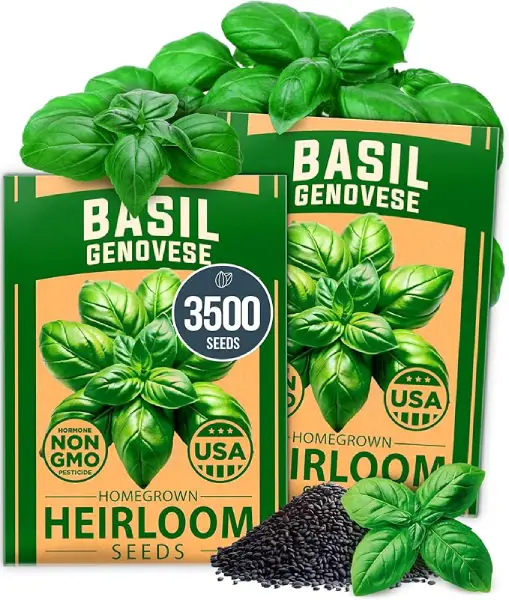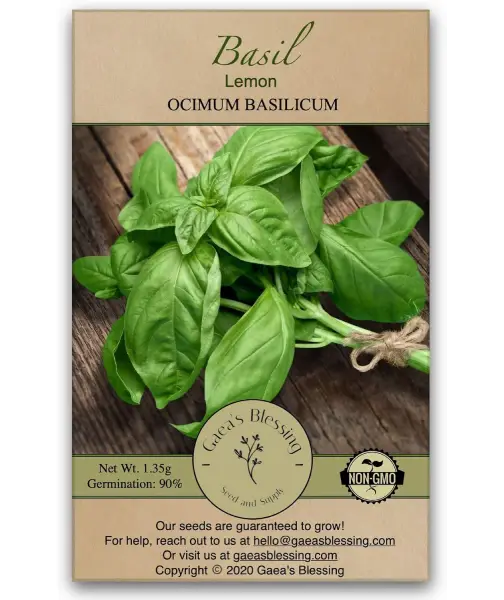Culinary Basil Herb Seeds
Basil is one of the most beloved herbs worldwide, known for its fragrant leaves and culinary versatility. Whether you want to make fresh pesto, enhance your salads, or brew a soothing herbal tea, growing basil from seed is an easy and rewarding experience.
In this guide, we’ll cover how to grow basil from seed, the different types of basil, their unique uses, and essential growing tips to help you cultivate a thriving basil garden.
How to Grow Basil from Seed
Starting basil from seed is straightforward, and with the right conditions, you can enjoy fresh basil all season long.
1. Choosing Your Basil Seeds
There are many basil varieties, so select one (or more) based on your culinary needs and growing conditions. We’ll discuss the different types below.
2. Planting Basil Seeds
- Best Time to Plant: Start basil seeds indoors 4-6 weeks before the last frost or sow them directly outdoors when temperatures stay above 50°F (10°C).
- Soil Requirements: Basil thrives in well-draining, nutrient-rich soil with a pH between 6.0-7.5.
- Planting Depth & Spacing: Sow seeds ¼ inch deep and space plants 10-12 inches apart for optimal growth.
3. Light & Water Needs
- Sunlight: Basil loves the sun! Ensure 6-8 hours of direct sunlight per day.
- Watering: Keep soil consistently moist but not soggy. Water at the base to avoid fungal issues.
4. Thinning & Transplanting
- When seedlings develop two sets of true leaves, thin them to one plant every 10-12 inches.
- If transplanting outdoors, harden off seedlings for a week before moving them to prevent shock.
5. Maintenance & Harvesting
- Pinch off flowers to encourage leaf production.
- Harvest leaves regularly by snipping just above a set of leaves to promote bushier growth.

Genovese Basil
✔️ Flavor: Classic sweet basil flavor with a slightly spicy undertone
✔️ Uses: Perfect for pesto, Caprese salad, pasta, and Italian dishes
✔️ Growing Tips: Pinch back frequently to prevent bolting and encourage bushy growth
Sweet Basil
✔️ Flavor: Mild, slightly peppery, and sweet
✔️ Uses: Versatile for sauces, soups, and fresh dishes
✔️ Growing Tips: Needs warm temperatures and frequent harvesting for continued growth


Lemon Basil
✔️ Flavor: Citrusy, fresh, and slightly spicy
✔️ Uses: Excellent for teas, seafood dishes, and lemony pesto
✔️ Growing Tips: Requires full sun and frequent harvesting to maintain flavor
Other Basil Types
🌿 Holy Basil (Tulsi)
✔️ Flavor: Slightly spicy, clove-like, and earthy
✔️ Uses: Used medicinally in teas for stress relief and immunity support
✔️ Growing Tips: Prefers warm temperatures and does best in full sun
🌿 Cinnamon Basil
✔️ Flavor: Spicy-sweet with a hint of cinnamon
✔️ Uses: Perfect for teas, fruit salads, and infused oils
✔️ Growing Tips: Keep soil consistently moist to enhance cinnamon-like aroma
🌿 Purple Basil (Opal Basil)
✔️ Flavor: Mildly spicy and slightly sweet
✔️ Uses: Adds color to salads, vinegars, and garnishes
✔️ Growing Tips: Needs ample sun to maintain deep purple coloring
🌿 Greek Basil
✔️ Flavor: Stronger, spicier than sweet basil
✔️ Uses: Ideal for Mediterranean dishes and fresh salads
✔️ Growing Tips: Compact variety, great for containers and small garden spaces
Essential Growing Tips for Healthy Basil
🌱 1. Pruning for Maximum Yield
- Always pinch above a set of leaves to encourage branching and prevent flowering.
- If basil starts to flower, remove the flower buds to keep the plant producing leaves.
☀️ 2. Ideal Growing Conditions
- Basil thrives in temperatures between 70-85°F (21-29°C).
- If growing indoors, use a grow light to supplement sunlight.
💦 3. Watering Wisely
- Avoid wetting the leaves to prevent fungal diseases.
- Water deeply but let the soil dry out slightly between waterings.
🍃 4. Best Companion Plants
- Basil grows well with tomatoes, peppers, and oregano.
- Avoid planting near sage or fennel, as they can inhibit growth.
🌍 5. Pest & Disease Prevention
- Ensure good air circulation to prevent fungal diseases like powdery mildew.
- Keep an eye out for aphids, whiteflies, and spider mites.
- Use neem oil or insecticidal soap if pests become an issue.
Growing basil from seed is an easy and fulfilling gardening project that provides fresh, aromatic leaves for months. With so many basil varieties to choose from, you can enjoy different flavors, fragrances, and culinary experiences.
By following the growing tips in this guide, you’ll have a thriving basil garden—whether in a raised bed, container, or windowsill. Start growing today and enjoy the incredible taste and health benefits of fresh basil! 🌿🍃
